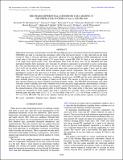THE PHASES DIFFERENTIAL ASTROMETRY DATA ARCHIVE. IV. THE TRIPLE STAR SYSTEMS 63 Gem A AND HR 2896
Author(s)
Muterspaugh, Matthew W.; Fekel, Francis C.; Lane, Benjamin F.; Hartkopf, William I.; Kulkarni, S. R.; Konacki, Maciej; Burke, Bernard F.; Colavita, M. M.; Shao, M.; Williamson, M.; ... Show more Show less
DownloadMuterspaugh-2010-THE PHASES DIFFERENT.pdf (454.9Kb)
PUBLISHER_POLICY
Publisher Policy
Article is made available in accordance with the publisher's policy and may be subject to US copyright law. Please refer to the publisher's site for terms of use.
Terms of use
Metadata
Show full item recordAbstract
Differential astrometry measurements from the Palomar High-precision Astrometric Search for Exoplanet Systems (PHASES) are used to constrain the astrometric orbit of the previously known [< over ~]2 day subsystem in the triple system 63 Gem A and have detected a previously unknown two-year Keplerian wobble superimposed on the visual orbit of the much longer period (213 years) binary system HR 2896. 63 Gem A was already known to be triple from spectroscopic work, and absorption lines from all three stars can be identified and their individual Doppler shifts measured; new velocities for all three components are presented to aid in constraining the orbit and measuring the stellar masses. In fact, 63 Gem itself is a sextuple system: the hierarchical triple (Aa1-Aa2)-Ab (in which Aa1 and Aa2 orbit each other with a rapid period just under 2 days, and Ab orbits these every two years), plus three distant common proper motion companions. The very small astrometric perturbation caused by the inner pair in 63 Gem A stretches the limits of current astrometric capabilities, but PHASES observations are able to constrain the orientation of the orbit. The two bright stars comprising the HR 2896 long-period (213 year) system have a combined spectral type of K0III and the newly detected object's mass estimate places it in the regime of being an M dwarf. The motion of the stars are slow enough that their spectral features are always blended, preventing Doppler studies. The PHASES measurements and radial velocities (when available) have been combined with lower precision single-aperture measurements covering a much longer time frame (from eyepiece measurements, speckle interferometry, and adaptive optics) to improve the characterization of the long-period orbits in both binaries. The visual orbits of the short- and long-period systems are presented for both systems and used to calculate two possible values of the mutual inclinations between inner and outer orbits of 152° ± 12° or a less likely value of 31° ± 11° for 63 Gem A and 10[° over .]2 ± 2[° over .]4 or 171[° over .]2 ± 2[° over .]8 for HR 2896. The first is not coplanar, whereas the second is either nearly coplanar or anti-coplanar.
Date issued
2010-10Department
Massachusetts Institute of Technology. Department of Physics; MIT Kavli Institute for Astrophysics and Space ResearchJournal
The Astronomical Journal
Publisher
IOP Publishing
Citation
Muterspaugh, Matthew W., Francis C. Fekel, Benjamin F. Lane, William I. Hartkopf, S. R. Kulkarni, Maciej Konacki, Bernard F. Burke, M. M. Colavita, M. Shao, and M. Williamson. “THE PHASES DIFFERENTIAL ASTROMETRY DATA ARCHIVE. IV. THE TRIPLE STAR SYSTEMS 63 Gem A AND HR 2896.” The Astronomical Journal 140, no. 6 (October 20, 2010): 1646–1656. © 2010 The American Astronomical Society
Version: Final published version
ISSN
0004-6256
1538-3881